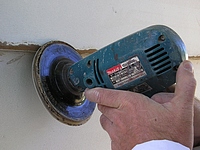Most interior and exterior paint jobs require at least some sanding. By removing surface defects, such as paint runs, brush strokes, and hard edges (especially when paint has been scraped away) you’ll help your paint adhere better and create a more beautiful finish.
Sanding is typically a multi-step process. Start with a coarse grit and progress to ever finer abrasives until the desired finish is achieved; a perfectly smooth surface will take a lot of time and effort. Depending on the finish you desire, you may be able to get away with less.
Ultimately, the amount of sanding you will do is up to you!
Sanding Tools
Depending on the project, you may need several different sanding tools.
Power sanders can make your job a lot easier! and disc sanders are used for smoothing large areas. Both are good options, but if you’re working with a soft, easily marred surface (like redwood or old masonite), a random orbital sander will produce fewer visible waves. For smaller areas, such as trim, use a palm or .
Hand tools, while more labor-intensive, are a necessary part of every job. Many crevices simply cannot be reached with power tools and must be done by hand. You should also use sandpaper or an abrasive sponge to go over areas previously smoothed with a power sander; this attention to detail will result in a smoother, more perfect surface.
Interior Sanding
Interior surfaces should be perfectly smooth before painting. Remove hard edges around chips and repairs and gradually “feather” to a smooth surface. Sanding can also be used to remove embedded dust that would show through your finish. On shiny painted surfaces, roughing up the surface a bit to give the new finish “tooth” (something to stick to) may be necessary.
Smooth large, flat areas with a disc or random orbital sander, and follow up by hand sanding. Always work with the direction of the grain. On stained surfaces, hand sanding is usually sufficient, unless you want to completely remove all of the existing finish.
Always finish sanding by vacuuming up all dust and debris, and wiping the surface with a tack cloth. A clean surface will produce a smoother finish.
Existing Painted Wood Trim
Achieving a smooth finish on previously painted wood trim always requires some effort. Remove heavy brush strokes or multiple layers of paint with 60-80 grit sandpaper or a medium-fine abrasive sponge. Remove sanding marks and smooth the surface with 120 grit sandpaper or the fine side of the sponge.
New Wood
 Smooth new wood with 120 grit paper and finish with 150 grit (or fine sponges.) Always sand in the direction of the wood grain. Pay special attention to smoothing raised grain. Shiny areas on the wood’s surface are called “mill glaze.” This is produced during shaping; it prevents stains from being absorbed and can also inhibit the adhesion of primer. Be careful to remove it completely.
Smooth new wood with 120 grit paper and finish with 150 grit (or fine sponges.) Always sand in the direction of the wood grain. Pay special attention to smoothing raised grain. Shiny areas on the wood’s surface are called “mill glaze.” This is produced during shaping; it prevents stains from being absorbed and can also inhibit the adhesion of primer. Be careful to remove it completely.
Exterior Sanding
Painted exterior wood surfaces should be sanded with power sanders. Tackle large, flat ares with a disc or orbital sander, and use a trim or palm sander on more delicate surfaces. Use a light touch, work on a large area, and keep the sander constantly moving to prevent gouging the wood or creating visible waves.
Wood Trim and Siding
Peeling exterior paint must be hand scraped. Then, remove any remaining loose paint with a power sander and feather the edges. If you’re dealing with multiple thick layers of paint, a coarse, 30 grit disk will remove the majority of the loose paint. Follow with 60 grit discs to remove any scratches and create a smooth surface.
Remember that a can be difficult to use, and sometimes leaves waves in soft woods. Use a light touch and, if you’re hesitant, use a finer sandpaper. The process will take longer, but you’ll be better able to control what you’re removing.
Masonite Siding
 Smoothing Masonite siding with a power sander can be done, but it is difficult. Use a disc sander or random orbital sander with a fine (60 or higher) grit for the best results. Because masonite is very soft, some waves are inevitable. Old masonite, in particular, is brittle and can be easily damaged. Use a soft touch and keep the sander moving at all times.
Smoothing Masonite siding with a power sander can be done, but it is difficult. Use a disc sander or random orbital sander with a fine (60 or higher) grit for the best results. Because masonite is very soft, some waves are inevitable. Old masonite, in particular, is brittle and can be easily damaged. Use a soft touch and keep the sander moving at all times.
Painted Windows and Doors
The vibrations produced by a power sander can break glass, so it’s best to sand windows by hand. First, remove loose paint, old caulking, and putty with a scraper. If the surface is rough, or if lots of flakes remain, use a coarse abrasive paper to remove it; follow with a higher grit to smooth the surface. Be cautious to limit your sanding to the wood and not the glass itself, or you might end up with permanent scratches in the glass!
Prepare painted doors with an orbital sander; use a sanding sponge to remove old finish from fine details and crevices.
Stained Windows and Doors
 Sanding stained surfaces is virtually the same whether you’re working on an interior or exterior project.
Sanding stained surfaces is virtually the same whether you’re working on an interior or exterior project.
Sand stained windows and doors by hand , using finer paper and sponges. If the finish is in good shape, smooth rough edges and brush marks with 180 grit abrasive paper or a fine sponge.
If the finish is in poor shape, remove the clear finish, with 120 grit paper. Smooth the remaining stained wood with 180 grit.


